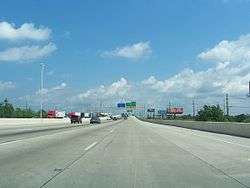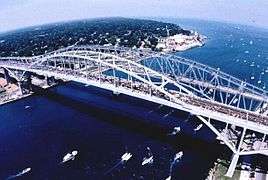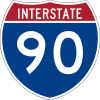Interstate 94
| |
|---|---|
 | |
| Route information | |
| Length: | 1,585.20 mi[1] (2,551.13 km) |
| Existed: | 1956 – present |
| Major junctions | |
| West end: |
|
| |
| East end: |
|
| Location | |
| States: | Montana, North Dakota, Minnesota, Wisconsin, Illinois, Indiana, Michigan |
| Highway system | |
Interstate 94 (I-94) is the northernmost east–west Interstate Highway connecting the Great Lakes and Intermountain regions of the United States. I-94's western terminus is in Billings, Montana, at a junction with I-90; its eastern terminus is the U.S. side of the Blue Water Bridge in Port Huron, Michigan, at the Sarnia, Ontario, Canada, border, where together with I-69 it meets Highway 402. Given this fact, I-94 is notable for being the only east–west Interstate Highway to form a direct connection into Canada connecting points from Seattle via I-90 to Toronto via Ontario Highway 401.
Lengthwise, I-94 is the eighth longest Interstate highway and is longer than all major north–south interstate highways except I-75 and I-95, meaning that I-94 is longer than I-5, I-15, I-25, I-35, I-45, I-55, I-65, and I-85. Additionally, it is the longest Interstate highway not ending in a 0 or a 5.
I-94 crosses I-90 several times: at its western terminus; near Madison, Wisconsin; in Chicago, and in Lake Station, Indiana.
Route description
| mi | km | |
|---|---|---|
| MT | 249 | 401 |
| ND | 352 | 567 |
| MN | 259 | 418 |
| WI | 348 | 560 |
| IL | 77 | 124 |
| IN | 46 | 74 |
| MI | 275 | 443 |
| Total[2] | 1604 | 2581 |
Montana

I-94 begins at Billings and travels northeastward toward Glendive before exiting the state to the east. I-94 links seven counties, which are Yellowstone, Treasure, Rosebud, Custer, Prairie, Dawson, and Wibaux counties and passes near or through Miles City, and Glendive while connecting with I-90 in Billings. The Highway is notable for following the Yellowstone River from Billings through Glendive. Beyond the western terminus of I-94, I-90 connects westbound I-94 travelers to points west such as Butte and Seattle, WA.
North Dakota

The route enters at Beach and passes through the Badlands near Medora (near the Theodore Roosevelt National Park South Unit). A public rest area about seven miles (11 km) east of Medora provides an awe-inspiring view, especially at sunset, and an opportunity to hike through some of the scenery on the Painted Canyon Trail. Further east, I-94 provides access to the North Unit of Theodore Roosevelt National Park, then passes through the cities of Dickinson, Mandan, Bismarck, Jamestown, and Valley City on the way to West Fargo and Fargo, where it leaves the state and crosses into Minnesota. Throughout the state, the route generally travels relatively straight east and west following both the railroad route and the former route of US Highway 10 (called "The Old Red Trail") where its western terminus is at exit 343 in West Fargo.
The highway intersects with the Enchanted Highway 11 miles (18 km) east of Dickinson at exit 72. At New Salem, it passes Salem Sue, a 38-foot (12 m) high sculpture of a Holstein cow and is clearly visible from I-94 on the south side of the road. A drive up the road to Sue will take visitors to a vantage point where you can see a panoramic landscape for many miles. Between Mandan and Bismarck, I-94 crosses the Missouri River with a view of the Northern Pacific/BNSF Railroad Bridge on the south side of the road. At Steele, it passes the world's largest sculpture of a sand hill crane (named Sandy), which is 40 feet (12 m) tall and visible from I-94 on the south side of the road, just to the east of exit 200. At Jamestown, it passes the world's largest sculpture of the buffalo (actually bison) named "Dakota Thunder", which is 28 feet (8.5 m) tall and is visible from I-94 on the north side of the road. At approximately mile marker 275 on the westbound lanes between Jamestown and Valley City, there is a small green sign marking the Laurentian Divide, which marks a continental divide where rivers south of the divide drain into the Gulf of Mexico, while the rivers north flow into the Arctic Ocean. The highway reaches Fargo, before the Red River.
Minnesota

Leaving Fargo, ND and entering Moorhead, MN, I-94 crosses the Red River. East of the Moorhead airport, the interstate travels in a northwest-southeast trajectory past Fergus Falls, Alexandria, and St. Cloud on the way to the Twin Cities, and eastward out of the state.
The road crosses the Mississippi River in Minneapolis between the Prospect Park and Seward neighborhoods. The highway joins Minneapolis and St. Paul together where it meets MN Highway 280.
In the Twin Cities, the routing of the highway is politically charged, primarily through many historic working-class and African-American neighborhoods.[3][4] In Saint Paul, the routing of I-94 is set through and displaces the historic Rondo neighborhood, which prior to the highway construction was the largest African-American community in Saint Paul.[5][6][4]
East of Saint Paul, I-94 leaves Minnesota between Lakeland, MN and Hudson, WI, while crossing the St. Croix River.
Wisconsin

Interstate 94 enters Wisconsin east of the Twin Cities at Hudson. It passes Eau Claire before turning southeastward and joining with Interstate 90 in Tomah and Interstate 39 in Portage. I-94 leaves I-90 and I-39 near Madison and resumes its easterly path toward Milwaukee before turning south and heading to Chicago, entering Illinois at Pleasant Prairie.
Illinois

In the state of Illinois, I-94 runs south from Wisconsin to Indiana via downtown Chicago. It is tolled on the Tri-State Tollway to the I-94/I-294 split; it then runs east to the Edens Expressway, where it turns south through the city of Chicago. At Interstate 80, I-94 runs east to Indiana on the Kingery Expressway.
Indiana

In the state of Indiana, I-94 runs east from Illinois concurrent with I-80. It crosses Interstate 90 (Indiana Toll Road), where I-80 joins I-90 east towards Ohio. I-94 continues northeast, paralleling the Lake Michigan shoreline into Michigan. The 55 mph speed limit used to continue east of exit 26; now it ends a mile east of I-80/I-90, where the speed limit goes up to 70 mph on EB I-94.[7] Between mile markers 0.0-15.5 are also posted along with I-80. Between mile markers 15.6-19.0, I-94 is posted alone.
Michigan

I-94 runs north along Lake Michigan to St. Joseph and Benton Harbor before heading east toward Detroit. It turns northeast to Port Huron where it meets I-69 and ends at the Blue Water Bridge, where it becomes Ontario Highway 402 in Point Edward, Ontario.
History
The first section of I-94 completed with Interstate funds (under the Federal-Aid Highway Act of 1956) was a 12-mile (19 km) section between Jamestown and Valley City, North Dakota in 1958.
North of Chicago, I-94 has been widened from six to eight lanes from Illinois Route 22 (Half Day Road) to just south of the Wisconsin state line at Illinois Route 173 and 95th Street to 159th Street. Starting in 2009, construction began to completely rebuild I-94, including expansion to eight lanes, from the Wisconsin-Illinois border through the Mitchell Interchange in Milwaukee. This construction is expected to be completed in 2021.[8]
In 2005, the I-94 bridge over the Crow River near St. Michael, Minnesota, about 35 miles (56 km) northwest of Minneapolis, was rebuilt. In 2006, a project to widen I-94 east of downtown St. Paul between Minnesota State Highway 120 and McKnight Road from four to six lanes was completed.
The new Marquette Interchange in downtown Milwaukee was completed in August 2008 at a cost of $810 million.
The interchange at 95th Ave. N in Maple Grove, Minnesota was rebuilt with a new, wider bridge that replaced the two-lane bridge there, which was demolished in July 2006.
In Detroit, Interstate 94 was routed over the existing Edsel Ford Freeway, and remained signed as such until the late 1980s when Michigan deemphasized proper names on Interstate guide signs. Its interchange with the Lodge Freeway, built in 1953, is significant as the first full-speed freeway-to-freeway interchange built in the United States.[9]
From September 2007 to October 2008, the Minnesota Department of Transportation (Mn/DOT) added a temporary extra lane to I-94 between northbound I-35W and MN-280 in the Twin Cities to help relieve traffic congestion caused by the collapse of the I-35W Mississippi River bridge. As a result, this portion of I-94 was not up to Interstate Highway standards during this time period.
Major intersections
- Montana
 I‑90 in Billings
I‑90 in Billings- North Dakota
 I-194 in Bismarck (unsigned, carried by the Bismarck Expressway)
I-194 in Bismarck (unsigned, carried by the Bismarck Expressway) I‑29 in Fargo
I‑29 in Fargo- Minnesota
 I-35W in Minneapolis; concurrent for less than one mile (1.6 km)
I-35W in Minneapolis; concurrent for less than one mile (1.6 km) I-35E in St. Paul; concurrent for less than half a mile (0.8 km)
I-35E in St. Paul; concurrent for less than half a mile (0.8 km)- Wisconsin
 I‑90 in Tomah; concurrent until Madison
I‑90 in Tomah; concurrent until Madison I‑39 at Portage; concurrent until Madison
I‑39 at Portage; concurrent until Madison
 I‑41 / I‑894 in West Allis
I‑41 / I‑894 in West Allis
 I‑43 / I‑794 in Milwaukee
I‑43 / I‑794 in Milwaukee

 I‑41 / I‑43 / I‑894 in Milwaukee
I‑41 / I‑43 / I‑894 in Milwaukee- Illinois
 I‑41 in Zion
I‑41 in Zion
 I‑294 in Deerfield
I‑294 in Deerfield I‑90 in Chicago; concurrent through to the junction with the Chicago Skyway
I‑90 in Chicago; concurrent through to the junction with the Chicago Skyway I‑55 in Chicago
I‑55 in Chicago
 I‑90 in Chicago
I‑90 in Chicago I‑57 in Chicago
I‑57 in Chicago


 I‑80 / I‑294 in South Holland; concurrent until Lake Station, Indiana
I‑80 / I‑294 in South Holland; concurrent until Lake Station, Indiana- Indiana
 I‑65 in Gary
I‑65 in Gary


 I‑80 / I‑90 in Lake Station
I‑80 / I‑90 in Lake Station- Michigan
 I‑196 near Benton Harbor
I‑196 near Benton Harbor I-194 in Battle Creek
I-194 in Battle Creek I‑69 in Marshall
I‑69 in Marshall I-275 in Romulus
I-275 in Romulus I‑96 in Detroit
I‑96 in Detroit I‑75 in Detroit
I‑75 in Detroit I‑696 in Roseville
I‑696 in Roseville I‑69 in Port Huron
I‑69 in Port Huron
Spur routes
- Bismarck, North Dakota: I-194 (unsigned)
- Minneapolis/St. Paul, Minnesota: I-394, I-494, I-694
- Milwaukee, Wisconsin: I-794 (Lake Freeway), I-894
- Chicago, Illinois: I-294 (Tri-State Tollway)
- Battle Creek, Michigan: I-194
References
- ↑ Federal Highway Administration (2002-10-31). "FHWA Route Log and Finder List: Table 1". Retrieved 2007-03-28.
- ↑ Route Log- Main Routes of the Eisenhower National System Of Interstate and Defense Highways - Table 1
- ↑ Rupar, Aaron (18 August 2014). ""Racist" Twin Cities maps make point about interstate highways". City Pages. Retrieved 13 July 2016.
- 1 2 Rupar, Aaron (19 August 2014). "St. Paul map shows how I-94 cut through heart of city's African-American neighborhood". City Pages. Retrieved 13 July 2016.
- ↑ "Rondo Neighborhood & I-94: Overview". Minnesota History Center - Gale Family Library. Retrieved 13 July 2016.
- ↑ Yuen, Laura (29 April 2010). "Central Corridor: In the shadow of Rondo". MPR News. Minnesota Public Radio. Retrieved 13 July 2016.
- ↑ "Speed limit to be raised on I-94 in Porter County, Indiana".
- ↑ "I-94 North-South Freeway Project Resources". Retrieved 2014-07-03.
- ↑ "Preliminary List of Nationally and Exceptionally Significant Features of the Interstate Highway System". Retrieved 2006-07-06.
External links
| Wikimedia Commons has media related to Interstate 94. |
- Interstate 94 at Michigan Highways
- Interstate 94 at Wisconsin Highways
- Illinois Highway Ends: I-94
- Indiana Highway Ends: I-94
- The Old Red Trail Documentary about the history of I-94 in North Dakota produced by Prairie Public Television
